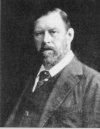 |
Bram Stoker1847-1912 |
 |
Bram Stoker1847-1912 |
Abraham (Bram) Stoker was born November 8, 1847 in Clentarf, Ireland.
For the first seven years of his life, Bram was bedridden by a lot of childhood disceases which gave him much time to read books.
A couple of years later he went Trinity College, Dublin.
Despite suffering from a speech-problem, Bram became a honor student. He was involved in soccer and was a marathon running champion. He was also involved in various literary and dramatic activities, a precursor to his later interests in the theater and his involvement with the rising action Henry Irving, whose performance he had critiqued as a student at Trinity.
After graduation from college, and in his father's footsteps, he became a civil servant, holding the position of junior clerk in the Dublin Castle.
His literary career began as early as 1871 and in that year he took up a post as the unpaid drama critic for the "Evening Mail," while at the same time writing short stories.
His first literary "success" came a year later when, in 1872, The London Society published his short story "The Crystal Cup".
As early as 1875 Stoker's unique brand of fiction had come to the forefront. In a four part serial called the "Chain of Destiny", were themes that would become Stoker's trademark: horror mixed with romance, nightmares and curses.
Stoker encountered Henry Irving again, this time in the role of Hamlet, 10 years after Stoker's Trinity days. Stoker, still very much the critic (and still holding his civil service position), gave Irving's performance a favorable review. Impressed with Stoker's review, Irving invited Stoker back stage and the resultant friendship lasted until Irving's death in 1905.
The Stoker/Irving partnership solidified around the year 1878. During this time Henry Irving had taken over his own theater company called the London Lyceum, but he didn't like the management, and therefore approached Stoker to handle business, at which point Stoker gave up his government job and became the acting manager of the theater.
A short time after Stoker began his new career, the publishing house of Sampson, Lowe contacted him expressing interest in a collection of Stoker's stories.
"Under the Sunset" was published in 1891 and was well received by some of the critics. By the time Stoker had received favorable reviews for his romance novel "The Snake's Pass" (1890), he was already making notes for a novel with a vampire theme.
In June 1897 "Dracula" was published. Reviews on "Dracula" were mixed, and the book never yielded much money for Stoker.
In a favorable review the "Daily Mail" compared it with "Frankenstein".
For the next few years after "Dracula's" publication, events took a downward spiral for both Irving and Stoker.
There were troubles with Irving's establishment and a fire destroyed part of the theater and Irving eventually sold it. Stoker did manage however to publish "The Jewel of the 7 Stars" in 1903, and it was a novel based on the information given to Stoker by an Egyptologist.
In 1905 Henry Irving died. A year after Irving's death Stoker wrote "Personal Reminiscences of Henry Irving".
Stoker managed to write other novels after this point until the time of his death 20 April 1912, at the age of 64.
Having some time at my disposal when in London, I had visited the British Museum, and made search among the books and maps in the library regarding Transylvania; it had stuck me that some foreknowledge of the country could hardly fail to have some importance in dealing with a noble of that country. I find that the district he named is in the extreme east of the country, just on the borders of three states, Transylvania, Moldavia and Bukovina, in the midst of the Carpathian mountains; one of the wildest and least known portions of Europe.
I was not able to light on any map or work giving the exact locality of the Castle Dracula, as there are no maps of this country as yet to compare with our own Ordnance Survey maps; but I found that Bistritz, the post town named by Count Dracula, is a fairly well-known place. I shall enter here some of my notes.
In the population of Transylvania there are four distinct nationalities: Saxons in the south, and mixed with them the Wallachs, who are the descendants of the Dacians; Magyars in the west, and Szekelys in the east and north. I am going among the latter, who claim to be descended from Attila and the Huns. This may be so, for when the Magyars conquered the country in the eleventh century they found the Huns settled in it.
I read that every known superstition in the world is gathered into the horseshoe of the Carpathians, as if it were the centre of some sort of imaginative whirlpool; if so my stay may be very interesting . . .
From the Introduction of Dracula, 1897